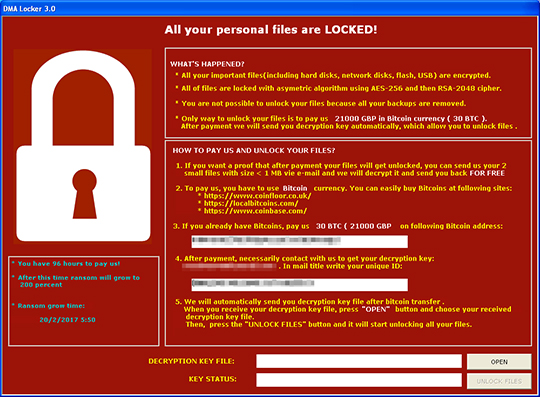RANSOM_DMALOCKER.AUSX
Ransom:Win32/DMALocker (Microsoft), HEUR:Trojan-Ransom.Win32.Agent.ilw (Kaspersky),
Windows


Threat Type: Trojan
Destructiveness: No
Encrypted: Yes
In the wild: Yes
OVERVIEW
This Trojan arrives on a system as a file dropped by other malware or as a file downloaded unknowingly by users when visiting malicious sites.
TECHNICAL DETAILS
Arrival Details
This Trojan arrives on a system as a file dropped by other malware or as a file downloaded unknowingly by users when visiting malicious sites.
Installation
This Trojan drops the following copies of itself into the affected system and executes them:
- C:\ProgramData\svchosd.exe
- C:\Documents and Settings\All Users\svchosd.exe
It drops the following files:
- C:\Documents and Settings\All Users\cryptinfo.txt ← ransom note
- C:\Documents and Settings\All Users\decrypting.txt ← encryption done marker
- C:\Documents and Settings\All Users\start.txt ← encryption start marker
- C:\ProgramData\cryptinfo.txt ← ransom note
- C:\ProgramData\decrypting.txt ← encryption done marker
- C:\ProgramData\start.txt ← encryption start marker
Autostart Technique
This Trojan adds the following registry entries to enable its automatic execution at every system startup:
HKEY_LOCAL_MACHINE\SOFTWARE\Microsoft\
Windows\CurrentVersion\Run
Windows Firewall = "C:\Documents and Settings\All Users\svchosd.exe"
HKEY_LOCAL_MACHINE\SOFTWARE\Microsoft\
Windows\CurrentVersion\Run
Windows Update = "notepad C:\Documents and Settings\All Users\cryptinfo.txt"
File Infection
This Trojan avoids infecting the following file types:
- .exe
- .msi
- .dll
- .pif
- .scr
- .sys
- .msp
- .com
- .lnk
- .hta
- .cpl
- .cmd
It avoids infecting folders containing the following strings:
- \Windows\
- \WINDOWS\
- Games
- \Temp
- \Sample Pictures
- \Sample Music
- \cache
- \Cache
Other Details
This Trojan does the following:
- It avoids encrypting Floppy and CDRom Drives.
NOTES:
The ransomware displays the following ransom note window:

SOLUTION
Step 1
Before doing any scans, Windows XP, Windows Vista, and Windows 7 users must disable System Restore to allow full scanning of their computers.
Step 2
Identify and terminate files detected as RANSOM_DMALOCKER.AUSX
- Windows Task Manager may not display all running processes. In this case, please use a third-party process viewer, preferably Process Explorer, to terminate the malware/grayware/spyware file. You may download the said tool here.
- If the detected file is displayed in either Windows Task Manager or Process Explorer but you cannot delete it, restart your computer in safe mode. To do this, refer to this link for the complete steps.
- If the detected file is not displayed in either Windows Task Manager or Process Explorer, continue doing the next steps.
Step 3
Delete this registry value
Important: Editing the Windows Registry incorrectly can lead to irreversible system malfunction. Please do this step only if you know how or you can ask assistance from your system administrator. Else, check this Microsoft article first before modifying your computer's registry.
- In HKEY_LOCAL_MACHINE\SOFTWARE\Microsoft\Windows\CurrentVersion\Run
- Windows Firewall = "C:\Documents and Settings\All Users\svchosd.exe"
- Windows Firewall = "C:\Documents and Settings\All Users\svchosd.exe"
- In HKEY_LOCAL_MACHINE\SOFTWARE\Microsoft\Windows\CurrentVersion\Run
- Windows Update = "notepad C:\Documents and Settings\All Users\cryptinfo.txt"
- Windows Update = "notepad C:\Documents and Settings\All Users\cryptinfo.txt"
Step 4
Search and delete this file
Step 5
Scan your computer with your Trend Micro product to delete files detected as RANSOM_DMALOCKER.AUSX. If the detected files have already been cleaned, deleted, or quarantined by your Trend Micro product, no further step is required. You may opt to simply delete the quarantined files. Please check this Knowledge Base page for more information.
Step 6
Restore encrypted files from backup.
Did this description help? Tell us how we did.

